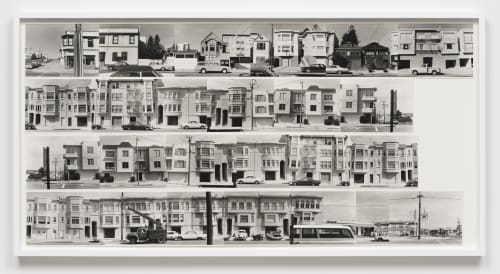Three Bay Area artists who banded together in the 1970s to explore conceptual photography are the subjects of a fascinating exhibition that just opened at the San Francisco Museum of Modern Art.
Led by Lew Thomas and joined by Donna-Lee Philips and Hal Fischer, they created works that question or explore the normal meaning of still photographs. They loved multiples, collages of shots that describe a larger whole, series of photos that suggested the passage of time or variations on a theme. They often annotated their pictures with words that explained (or sometimes undercut) the visual evidence. They wrote about each other’s work and distributed their critiques in self-published books.
Thomas’s approach was the closest to the “straight” documentary style that had dominated photography for half a century, though he added touches of Dada and Pop. Phillips was more introspective and questioning, while Fischer operated as a sort of anthropologist of the emerging gay community in the Castro District of San Francisco.
In 34th Avenue Between Geary and Clement of 1972 (top image), Thomas combines 24 separate photos of an unremarkable neighborhood in the city in four long horizontal strips. The boxy two- and three-story houses are shot in a deadpan style, with cars parked on the street and almost no visible pedestrians. It’s a San Francisco echo of — or homage to — Ed Ruscha’s Every Building on the Sunset Strip of 1966.
Thomas employs the same strategy on other subjects: a dozen pictures of a bathroom sink being filled and then emptied; 36 shots, displayed six by six, of a sprinkler as it rotates through a full circle of watering a lawn; nine images of sections of a vacuum cleaner, arranged to show the whole machine. Their use of everyday objects and a sly sense of humor reminds you of Marcel Duchamp.
In Time Equals 36 Exposures of 1971, Thomas documents a GraLab darkroom timer as its second hand winds through a minute.The 36 images of the black timer with white lettering are repeated in negative, with another 36 images of black lettering on a white background. It’s a commentary about the passage of time, but it also seems like an inside joke on the often boring, repetitive nature of darkroom work.
Phillips, by contrast, is represented by half a dozen series that directly explore the meaning of things. In 100 Small Chairs, More or Less of 1981, she annotates 25 identical photos of a bentwood chair with short labels underneath, ranging from “This is certainly a chair” to “This is the image of a chair” to “This is a photograph” to “This is not a chair” (hello, Magritte).
Her 1983 series What Do I Mean When I Say Red? What Do You Mean? depicts a variety of ordinary red objects — a stop sign, a stack of Campbell’s Soup cans, a pair of strappy high-heel women’s shoes — and labels them with one of the series title’s two questions.
In her autobiographical Fragments From a Visual Journal of 1977, Phillips sits in front of the camera in 24 similar shots wearing a variety of clothing — a striped sweater, a leotard, a kimono — or nothing at all. On the left side of the pictures are typewritten excerpts from her journal. In one, where she wears a T-shirt printed with “I AM AN IMAGE,” the text says she wonders “if what I am doing” is worth it at all.
In Fischer’s half-dozen series, on the other hand, he seems to know exactly what he’s doing. Gay Semiotics of 1977 decodes the street style of the Castro neighborhood with wit and clarity, using labels and text blocks in a mock-academic style to explain to the viewer what’s significant.
In Signifiers for a Male Response from that series, he shows a young man in jeans and leather jacket from behind, with labels pointing to his earring, the keys hanging from his belt, and the handkerchief dangling from his left back pocket as signs of gayness. In other annotated images in Gay Semiotics, he presents a catalog of street fashion such as the hippie, the jock, the urbane guy, and the leather boy.
In the series 18th Near Castro St. x 24, Fischer photographs a sidewalk bench at a bus stop once an hour for 24 hours. Below each picture is an explanation of who’s present and what’s going on — old-timers getting together in the morning, gays sunning themselves in the afternoon, dopers getting high in the evening, an empty bench at 2 a.m.
It’s a tour-de-force.
Thought Pieces: 1970s Photographs by Lew Thomas, Donna-Lee Phillips, and Hal Fischer runs through August 9 at the San Francisco Museum of Modern Art, 151 Third Street, San Francisco.
Top image: Lew Thomas, 34th Avenue Between Geary and Clement, 1972, San Francisco Museum of Modern Art, gift of Jane and Larry Reed; © Lew Thomas.

